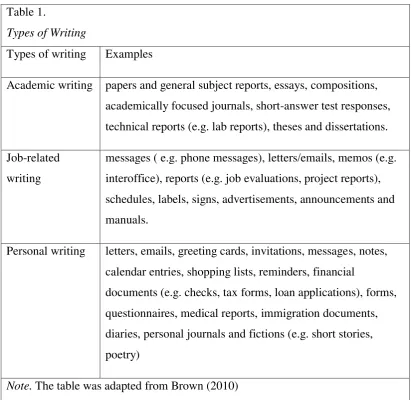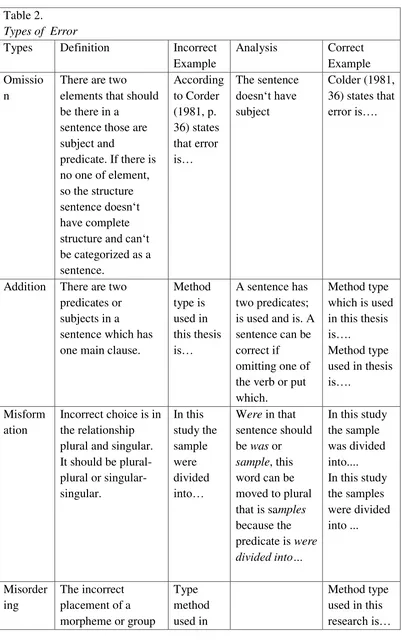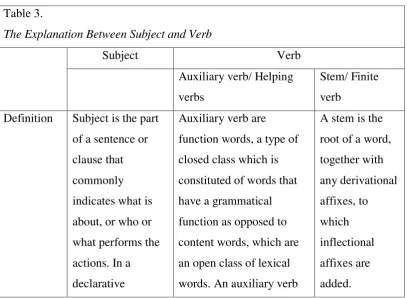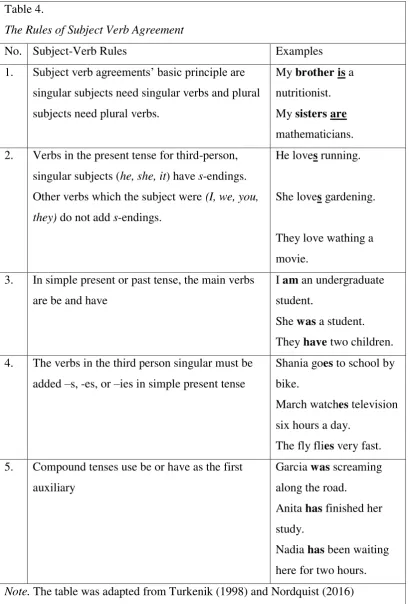Chapter Two
Literature Review
As stated in the previous chapter, the aims in this research are to know error types and to calculate the subject-verb agreement error in essay writing class. Therefore, the discussion in this chapter will focus on the experts‟ opinion
underlying the research. This chapter explains the writing definition, writing types, and the importance of writing. Also, it presents the error definition, error types, error analysis, subject-verb agreement and some reviews of related study are highlighted in this chapter. Finally, this chapter explain the conceptual framework of the study.
Writing
Here, the researcher will discuss some point about writing, such as writing definition, writing types, and the importance of writing.
Writing definition. The writing definition can widely be revealed from
several perspectives. Writing is a more complex than creation of graphic symbols. Lennon (1989) as cited in Karlina (2014) viewed writing as, “the process of transforming the material discovered by researcher inspiration, accident, trial or whatever into a message with a definite meaning – writing is a process a
deliberate meaning” (p. 27). It means that writing must convey a message with a
meaning.
students should think about the readers. Based on those theories, it can be concluded that writing is a complicated process that makes the students explore their personal feeling and ideas to be something visible.
Writing is the central subject in the curriculum, and it is taught in every grade level. Warschauer (2004) argued that writing is especially important for the instruction of second language learners. Also, there has been a major modification in thinking in the last few decades about what should be taught in writing and how it should be taught (Kennedy, 1998).Writing is categorized as one of the
productive skills that the learners or students must learn and master (Nurjannah, 2012). To run the learning process, the students must be able to write.
Some expert argue that, writing skill is the hardest skill in learning English for students. It can enhance language acquisition when they explore their thoughts because the thought also participate in the language structures and vocabulary when they are learning in the classroom. It is supported by Fitriani (2010) that writing is one kind of expression in language which is created by particular symbols, having conventional values for representing the wordings of particular language which is drawn up visually. Brown (2007) also stated that writing is the written products of thinking, drafting, organizing them coherently, revising text for clearer meaning, editing text for appropriate grammar and producing a final product. Writing skills are difficult due to the fact that it involves a
comprehensive knowledge of ideas, vocabulary, grammar, and format.
produce, within and beyond the requirements of a curriculum, consist of three categories. They are academic writing, job-related writing, and personal writing. Furthermore, this research focuses on the academic writing.
Table 1.
Types of Writing
Types of writing Examples
Academic writing papers and general subject reports, essays, compositions, academically focused journals, short-answer test responses, technical reports (e.g. lab reports), theses and dissertations. Job-related
writing
messages ( e.g. phone messages), letters/emails, memos (e.g. interoffice), reports (e.g. job evaluations, project reports), schedules, labels, signs, advertisements, announcements and manuals.
Personal writing letters, emails, greeting cards, invitations, messages, notes, calendar entries, shopping lists, reminders, financial
documents (e.g. checks, tax forms, loan applications), forms, questionnaires, medical reports, immigration documents, diaries, personal journals and fictions (e.g. short stories, poetry)
Note. The table was adapted from Brown (2010)
requirement of a college or university. To sum up, academic writing could be any writing assignment given in an academic setting, used for publications that are read by teacher and researcher, or presented at conference.
In contrast to academic writing, there are job-relating writing and personal writing. Job relating writing is a formal writing, but has a different structure with the academic writing. If academic writing should consist of at least five
paragraphs, job relating writing and personal writing should not. The structures of academic writing according to Gillet (2017) are introduction (one paragraph), body (three paragraphs) and conclusion (one paragraph).Then, not like the other type of writing, academic writing has their own rules to be done including the structure, diction, formatting, and the goal itself.
In fact, essay increases the analytical and intellectual abilities of the writer as well as the readers. It evaluates and tests the writing skill of the writer and organizes his/her thinking to respond personally or critically to an issue. Through an essay, the writers present their arguments in a more sophisticated manner. In addition, it encourages the students to develop concepts and skills such as
analysis, comparison and contrast, clarity, exposition, conciseness and persuasion (Literary Devices, 2010). Those are the urgency of choosing essay as the main subject for this research.
The importance of writing. As one of the four basic skills, writing absolutely has several benefits for all aspects in human‟s life. In university,
writing is definitely as a part of learning since the students write the assignment. The assignment may range from one paragraph to several paragraphs. The
students also have to write an answer on activities or test and exam in the form of a few sentences or a complete essay (Zeemach & Rumisek, 2003). It means that writing should be conducted well in the language learning activities.
The other reason why writing should be included in the syllabus is because it is an essential aspect for students‟ academic success. The success in academic
can be seen by the final assessment that is almost done through writing. According to Kellogg (2008), writing helps students to strengthen the
grammatical structure, develop the students‟ vocabulary and assist other language
proficiency like reading, listening and speaking. It is clear that writing improves another language skill. From those experts‟ opinion, it seems that writing ability
To conclude, writing is very important in students‟ life. Writing always becomes the form of the assignment and final assessment in education. Writing is the way to measure the students‟ competencies. It also reflects the proficiency of
the students. Until now, writing should be included in the syllabus for achieving the success of a teaching learning process. The success of a teaching learning process could be measured from the credits of the students.
Error
The field of error is closely associated with the work of Corder (1967) which defined “errors” as systematic errors that are errors of competence. He
made out a case examining errors as a way of investigating a learning process. (Ellis, 2015) argue that error may cause of transferring first language habits into target language or the learners process in learning which is in this study is English. Error appeared to go through stages of acquisition, as the nature of the errors. Students make errors in both comprehension and production.
Some people would feel difficult to differentiate error and mistake. (Ellis, 2015) continued explained the differences of them are the systematic error which is made by students. Error reflects gaps in students‟ knowledge. It occurs because the students do not know what is right. In the other hand, mistake reflects
occasional lapses in performance. It occurs because, in a particular case, the students are unable to perform what they know.
In short, the differentiations between error and mistake could be seen from the students‟ ability. The ability refers to the correctional ability. The
target language such as grammar. It was error when the students cannot do the self-correction on their writing. It was a mistake when the students could do the self-correction on their writing.
On the other hand, Brown (2001) as cited in Al-Dubib (2013) defined errors as a product made by learners that can be observed, analyzed, and classified to reveal their learning systems. Mentioned by Gustilo and Magno (2012, p. 3), “an infringement or deviation of the code of the formal system of communication through which message is conveyed”. To summarize, error that the researcher
means is the linguistic form made by learners that can be observed, analyzed, and classified, under similar conditions and context by the native speaker.
The researcher intends to analyze the grammatical error that occurred on the students‟ writing. Then, Corder (1981) argued that error can also be a
measurement to the learners in learning language. Error that researcher would like to analyze is the error which appears in form of grammatical especially in subject-verb agreement which the subject were I, we, you, they, she, he, and it. In short, the students have their ability in understanding grammar, but the way they write is not reflecting what they have learned.
Table 2.
Types of Error
Types Definition Incorrect
Example
predicate. If there is no one of element, so the structure sentence doesn„t have complete structure and can„t be categorized as a sentence.
Addition There are two predicates or
Error Analysis
Corder (1981) created a certain analytical tool that can be used in order to find errors in texts which is called as error analysis. Error analysis is described as “a set of procedures for identifying, describing and explaining learners‟ errors”
(Ellis & Barkhuizen, 2005, p. 51). It is crucial to point out that error analysis is about not only identifying and detecting errors but also trying to explain the error itself. When investigating second language learners‟ material, there are several
methods that can be used to collect data for the research. According to Ellis and Barkhuizen (2005), the best method to investigate second language acquisition is by collecting samples of the learner‟s productive English.
When conducting an error analysis there are some steps that are included in the process. Based on Ellis and Barkhuizen (2005), those steps are collection of samples of language learners, identification of the error, and the description of the error.
Collection of a sample of language learners. When collecting data, the
purpose of the study must be considered. Then try to collect relevant data for the aim of the study. The data also should answer research questions.
Identification of errors. Before analyzing a text, it is important to define
what an error is. After that, it is essential to set parts of error that need to identify, of morphemes in an
utterance.
this research is…
for example grammatical error. Identifying grammatical errors in English learners‟ texts must reflect to the correct grammar.
Description of errors. In order to describe an error, one has to specify how the English learner‟s error differs from the world Englishes. The researcher
would describe the total amount of error in subject-verb agreement into number. Number could refer to the trustworthy of the findings of this study.
The Agreement between Subject and Verb
Sentences may have corellation in many different ways called “sentences correlatedness” stated by Fromklin, Blair and Collins (2000) as cited in Agustina
(2016) and the relationship between subject and verb in a sentences is called subject-verb agreement. This is how to make a intelligible sentence. Thus, below table about the brief explanation between subject and verb.
Table 3.
The Explanation Between Subject and Verb
Subject Verb
Auxiliary verb/ Helping verbs
Stem/ Finite verb
Definition Subject is the part of a sentence or function words, a type of closed class which is constituted of words that have a grammatical function as opposed to content words, which are an open class of lexical words. An auxiliary verb
sentence, the subject usually appears before the verb.
is used to add functional or grammatical content to the information expressed by does, doing); have (have, has, having); may; might; must; shall; should; will; would.
Example The cat is sleeping.
My sister’s Note. The table was adapted from Nordquist (2016) for subject and auxiliary verb also Cristal and Mish at SIL International (2004) for stem.
Subject-verb agreement. Adapted from Turkenik (1998) and Nordquist (2016), subject-verb agreement is a part of grammar that explains the correct usage of verb or auxiliary verb and stem based on the subject. There are five basic rules of subject-verb agreement as written as follows:
Table 4.
The Rules of Subject Verb Agreement
No. Subject-Verb Rules Examples
1. Subject verb agreements‟ basic principle are singular subjects need singular verbs and plural subjects need plural verbs.
My brother is a nutritionist. My sisters are mathematicians. 2. Verbs in the present tense for third-person,
singular subjects (he, she, it) have s-endings. Other verbs which the subject were (I, we, you, they) do not add s-endings.
He loves running.
She loves gardening.
They love wathing a movie.
3. In simple present or past tense, the main verbs are be and have
I am an undergraduate student.
She was a student. They have two children. 4. The verbs in the third person singular must be
added –s, -es, or –ies in simple present tense
Shania goes to school by bike.
March watches television six hours a day.
The fly flies very fast. 5. Compound tenses use be or have as the first
auxiliary
Garcia was screaming along the road.
Anita has finished her study.
Reviews of Related Study
In conducting the research, the researcher examines and relates the research to some other studies. There are several studies concerning with error analysis in writing. The previous studies which will be reviewed are about the error analysis in writing.
Wahyudi (2012) entitled “Error analysis on subject-verb agreement: the case of university students in Indonesia” attempted to analyze the errors made by a first-semester student of the English Department, Faculty of Humanities and Culture, Maulana Malik Ibrahim State Islamic University, Jawa Timur, Indonesia. The student was a 19-year-old male majoring English at the university, and they were in his first semester. They were asked to do three separate tasks, each of which included writing essays of 250 words. The research examined the errors in subject-verb agreement of the student‟s writing, and its taxonomy was based on Duley, Burt, and Krashen (1982), who categorize errors as those of omission, addition, misformation, and misordering. The learner made a significant number of errors in each task with an accuracy of 46.42% incorrect use of verb to be agreement (omission error = 3 times and misformation = 12 times) in the first composition, 31.58% (omission = 5 times and misformation = 21 times) in the second composition, and 40.62% (omission = 3 and misformation = 16 times) in the third composition.
Al Dubib‟s research (2013) entitled “Error analysis on subject-verb agreement in writing of EFL Saudi female students : a corpus based study”
Translation College of Prince Noura University, Riyadh, Saudi Arabia. The teachers used the Writing Process Approach to teach writing skills. The study was designed to explore whether students are facing problems with subject-verb agreement in terms of the present tense of the verb to be in their writing and identify the causes of these problems. The findings revealed that they had problems in applying this rule in their written production and lack of knowledge of English grammar is the main source of students‟ errors.
The other research conducted by Agustina (2016) entitled “Error analysis in composition written by Nursing Department students of Universitas
Muhammdiyah Yogyakarta” wanted to know the students‟ language competence
by viewing the errors they made in the sentence viewed from subject-verb agreement. Qualitative method was used in this research. The findings showed that some problems with Subject-Verb Agreement included a sentence with no verb, problems with modals which is not followed by stem, problems with the auxiliary verb, problem with the inflexional –s for the third singular person, and
problems with be+ stem or just Subject+Ving without be. The research technique to analyze the error using Concordance program would make the researcher easier to sort that word in database.
Furthermore, Wahyudi (2012), Al-Dudib (2013), Agustina (2016) conducted research about error analysis on students‟ writing. If Wahyudi (2012)
did in English department, the researcher did a research in non- English
researcher would like to apply the same method used in this research which is error analysis. The researcher used the Ant Concordance program to help in sorting sentences by seven keywords in this research. Before that, the researcher typed the entire hardcopy document. After that, the researcher classified error by the seven keywords and analyzed the error types manually.
Conceptual Framework
The researcher is interested in taking this research topic because there are many errors still done by the UMY students‟ when writing an essay proved by the previous research by Agustina (2016). As already described in the literature review, error is an unintentional mistake made by students or learner. If these errors are not evaluated by the teacher, students will repeat doing the error continuously. Producing error in the future should be prevented.
Error occurs because the lack of students‟ ability in understanding target language which in this study is English. Since the discovery of errors is not intentional, the need of a way to be able to change the error is important. Therefore, the error will not happen again.
Then, error analysis is a way for analyzing the error. Language is seen from the selection or diction of words and grammar itself. Writing is not
combining many words in improper grammar. Grammar is a rule that need to be mastered by students.
This invites students and teachers to be more sensitive in the importance of subject-verb agreement in writing. The urgency in making a sentence is on
verb. They can apply the subject-verb agreement rules that have learned in essay writing class. Thus, students will be more aware of writing with subject-verb agreement so that the reader will understand an will not miscommunication.
Based on that, the conceptual framework of this study is described on the following figure:
Figure 1. Conceptual framework
The researcher collected the essay from an essay writing class. Essay documents from students were seen as the main data of this research. All the data of this research were seen as the sentence level. The sentence consisted of subject and verb. The subject limited into pronoun includes I, we, you, they, she, he, and it.
Verb
Sentence
Auxiliary Stem
Pronoun
Error Analysis
All sentences were identified based on the subject. Every sentence with subject “I” was gathered, so was the sentences with subject we, you, they, she, he, and it. After that, the researcher did analyzing part one manually, separated the right sentences and the error sentences or called as determining the data. Then, analyzing part two focused on the error sentences and divided them into four categories which are omission, addition, misformation, and the misordering. Shorting sentences by it subject could be done using Ant Concordance program, but analyzing the sentences was done manually by the researcher.




